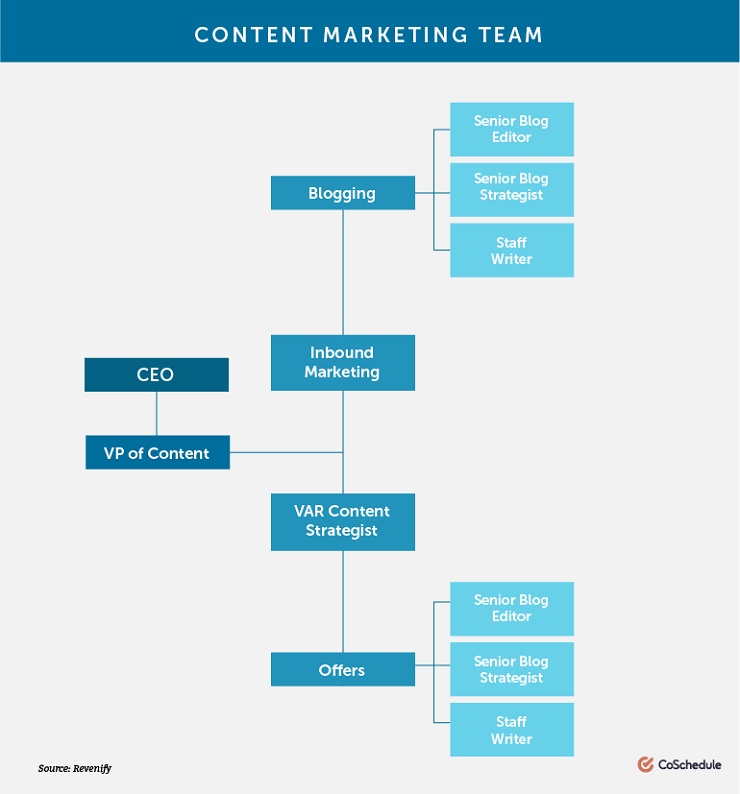In a time when traditional advertising is seen as “pervasive, obnoxious, and intrusive,” you may have joined the masses of marketers switching to a content-based strategy—one that focuses on providing value and engaging with audiences in more meaningful ways.
And as you may have already discovered, it takes a village to execute a proper content marketing strategy.
So if your next plan of action is to build a content marketing team that lets you scale your content creation, and ideally your company, keep reading.
In this blog post, I’ll explain why you should create a content marketing team, the pros and cons of hiring your own team or going with an agency, as well as how to build your own team from scratch, so you can scale your marketing efforts and make more sales.
Why Create a Content Marketing Team?
There are a few important benefits that come with building a content marketing team.
For starters, the content marketing approach itself has a lot to offer. It helps you connect with audiences by providing value and increasing engagement. Ad blockers are now more popular than ever (30% of internet users reportedly use one), so a content marketing team can help you reach your audience when traditional banner ads just don’t deliver.
Having a content team can help you nail that approach while keeping in mind long-term company goals. Having people dedicated to brainstorming, producing, and distributing high-value content helps you deliver brand experiences that make a bigger impact on audiences.
While building a team may seem like a huge cost, it likely makes sense for your bottom line: content marketing efforts can cost up to 62% less than traditional marketing campaigns while delivering up to three times more leads.
78% of consumers prefer getting to know a company through valuable articles than traditional ads. Source
Hiring Your Own Team Versus a Third Party
One question you might have wrestled with is whether you should you hire your own team, or a third-party content marketing agency instead? There are pros and cons to each, of course, so I’ll discuss them and then give my personal recommendation.
Content Marketing Agency
Pros
- May be cheaper than hiring individual employees for the team
- Agencies already have teams of professionals in their field to do most content marketing responsibilities, saving you time in recruiting and onboarding
Cons
- Because they aren’t your employees, you might have issues dealing with deadlines, as agencies typically have several clients and projects besides yours
- Not all content marketing agencies are created equal: some agencies have no experience in your niche and might not be able to deliver as in depth of content as you’d like
In-House Content Marketing Team
Pros
- Have a deep understanding of your company’s goals, products, culture, and competition
- Can give updates on short notice
- All their working hours are dedicated to your company’s projects
Cons
- Takes time and resources to hire and onboard
- May be prone to tunnel vision, or only seeing things from a certain perspective
Given these pros and cons, which one should your company choose?
My recommendation: co-sourcing.
What this means is you can hire key players to be full-time, in-house employees, while outsourcing certain roles and deliverables to agencies or freelancers.
This is the way to get the best of both worlds, by keeping the best talent as full-time employees while getting an agency’s talent to fill in the gaps.
Steps to Create a Content Marketing Team
Ready to start building your own content marketing team? Here are seven steps to get started.
1. Choose Between In House vs. Remote
Because advancements in technology have allowed content teams the luxury of working remotely, you might have found yourself debating between letting employees work in house or remotely.
One advantage of letting employees work in house is being able to get updates as quickly as possible, while fostering better relationships within the company. When people are able to see each other at work, it’s easier to brainstorm.
On the other hand, remote working can save you the overhead costs of maintaining an office. And because many candidates in the labor market today value the opportunity to work from anywhere, you may get access to better talent and retain employees longer.
In my content marketing agency, I’ve built a completely remote content marketing team with people from all over the world. To manage my business better, my team and I communicate regularly via Skype or Slack, collaborate on project management tools, and set clear deadlines and goals.
Some of the fastest-growing content teams now use a hybrid model: core strategists and editors in-house, paired with a global network of freelance creators. Asynchronous tools like Notion, Loom, and Trello allow these teams to stay aligned without needing constant check-ins.
Here are a few questions to guide you as you decide whether to take your team in house or keep them remote:
- Can you afford office rent for your entire content marketing team?
- Do your team members live in the same city?
- Do you need to meet your content marketing team regularly (at least once a week)?
If you answered yes to most of these questions, you may benefit from keeping your team in house.
Some factors that will, of course, require a remote team are:
- Where your talent is located. Are they based all over the world or in different cities?
- Is your remote team made up of freelancers?
- How well can team members collaborate digitally instead of through in-person meetings? If your team consists of digital nomads, for example, they’re more likely to be comfortable doing video conference meetings, responding to project updates via text, and using real-time collaboration tools like Google Suite or Asana.
2. Develop Your Team’s Structure
To guide your hiring and onboarding process, create a team structure that assigns different goals for your content marketing team members. A solid team structure can help inform different roles and responsibilities.
As your content engine matures, you’ll want to organize by function. E.g., one pod for blog production, another for YouTube, and a third for performance content. Each pod owns its own research, calendar, and publishing goals.
Consider what sub-teams you’ll need to report to different leaders and managers in your company. Make sure to keep the structure clear and organised, so that you don’t risk overlapping of responsibilities and cause internal confusion.
An example of a very simple modern content marketing team structure. Yours may vary depending on your industry and company goals.
When you’re building your content marketing team for the first time, the Content Marketing Institute recommends a T-shaped professional model to start. This model suggests hiring people who have basic knowledge across a horizontal T but have comprehensive knowledge in one area, or the vertical T (see below).
So when you’re hiring people to fill out roles on your team and assigning them to sub-teams, you want them to know how each sub-team operates. For example, a content writer has basic knowledge about social media promotion, visual branding, SEO, and like, but needs room to apply their own expertise—writing in-depth articles that provide value to readers and audiences.
Another thing you can consider as you plot out your structure: if you’re only just starting your team or lack the budget to hire all at once, prioritize your managing editor, content writers, graphic designers, SEO specialists, analytics experts, and web developers before filling out more specialized positions.
3. Make a List of the People You Need
The success of your content marketing team hinges on more than just hiring “a writer” and “a designer.” To scale without chaos, you need a mix of strategic thinkers, technical specialists, and flexible doers. But that doesn’t mean hiring everyone at once.
Start with functions, not just titles
Break your content operation into four core functions:
| Function | What They Do |
|---|---|
| Strategy | Plan content direction, goals, themes, funnel fit |
| Production | Create blog posts, videos, visuals, and emails |
| Optimization | SEO, analytics, repurposing, testing |
| Distribution | Share content across social, email, PR, and ads |
This model keeps your organization nimble as you scale.
Roles to prioritize first (your “core four”)
If you’re starting lean, focus on four high-leverage roles:
-
Managing Editor / Content Lead
Sets the calendar, manages writers, and owns quality. Think of them as your “content PM.” -
Content Writer / Creator
Produces SEO content, scripts, newsletters, or whatever format drives growth. You want T-shaped creators here—someone strong in one format (e.g., blog or short-form video) but fluent in others. -
SEO & Content Analyst
Does keyword research, audits, and performance tracking. Often freelance or part-time, but essential to make sure your content drives ROI. -
Content Distribution Specialist
Gets your content seen—via email, social, community, influencer outreach. (If you can’t hire for this yet, your editor should at least own promotion playbooks.)
Advanced roles to layer in as you scale
Once your engine’s running, you’ll want to fill more specialized seats:
-
Content Operations Manager – Owns workflows, briefs, content systems, and deadlines. This role unlocks true scale.
-
Repurposing Specialist – Transforms long-form content into concise, short-form formats (e.g., blog posts, Twitter threads, emails, carousels).
-
Scriptwriter / UX Copywriter – For video teams or SaaS onboarding flows.
-
AI Tools Integrator – Knows how to use SurferSEO, Jasper, or ChatGPT to draft outlines, briefs, or optimize existing content.
-
Brand Editor / Copy Chief – Ensures brand voice and tone are applied consistently across channels.
Note: Many of these roles start part-time or outsourced, and that’s okay. What matters most is covering the function, not padding the headcount.
The smart way to assign roles early on
Instead of filling seats one by one, use a “function-first” mapping approach.
Here’s a sample matrix:
| Function | Who Owns It? (Now) | Who Owns It? (Future) |
|---|---|---|
| Blog creation | You + freelance writer | Full-time writer |
| SEO strategy | Consultant | In-house SEO specialist |
| Distribution | Social media manager | Distribution lead |
| Analytics | You | Content analyst |
Use this to plan your next hires or agency partners based on what’s slowing down your content engine.
Pro Tips for Team Building
-
Don’t overhire generalists. Hire for a clear strength (e.g., great storyteller, sharp SEO) and build out horizontally with support.
-
Look for people who’ve worked in content pods, cross-functional teams built to own an entire piece of the funnel (e.g., product education).
-
Create clear ownership from day one. A content calendar is useless if no one owns delivery.
4. Have the Right Tools in Place
To effectively manage your team and monitor your campaigns and goals, invest in the right tools.
It’s not about how many tools you use—it’s how well they work together. For example, pair Trello with a Notion editorial wiki and use Zapier to automate status updates between the two. This lets your content flow without chasing people on Slack.
Use content management systems, such as WordPress or Joomla, for editors and writers, IDEs (Integrated Developer Environment) for web developers like Visual Studio Code or Bluefish, graphic and video-creation tools for multimedia creators like Adobe products or Final Cut Pro, and the like.
I mentioned previously that in my own company, I use Slack and Skype to manage communication between my team and myself, but we also use Asana for managing our content calendar and seeing which stage every project is at.
Asana can be a great tool for a content calendar.
5. Create an Onboarding Strategy
Once you’ve hired your team, it’s time to onboard them. As a best practice, create onboarding documents that you can store and send to leaders and managers to help them train new hires.
My company uses onboarding documents for new content writers. Some resources I give them are checklists to go through before submitting articles, as well as the main goals of our company.
To ease new hires in, you can send them these documents you’ve prepared and go through them together.
Here are a few practices to follow when onboarding new hires:
- Pre-onboarding, have necessary documents such as work contracts signed and filed.
- Create your onboarding document. This board template by Trello can serve as a great start, where you can help new hires remember things you may have oriented them on their first few days. It includes things like who to talk to for specific concerns and even reiterates company goals.
- Plan out each new hire’s first day on the job. You may want to introduce them to the rest of your content team, inform them who they report to, and then help them jump into their first project as part of the team.
- After their first week, send an onboarding survey that can help you determine whether they’re clear in their new position and how they’re doing in your company so far.
6. Craft Your Content Marketing Playbook
Next, your content marketing team needs to have some kind of playbook so that all your content has a unified look and sound. Here are the elements you need to craft your own content marketing playbook.
Style Guide
A style guide helps inform designers and editors how to present your content and brand. These are typically visual elements, such as infographics and videos, but can also be applied to elements like blog post formatting.
Adobe has a comprehensive style guide that tells designers how to use its logo, the specific colors it uses across materials, as well as the kinds of images it uses across its website and brand collateral.
To create your own style guide, refer to this complete post by Canva.

Brand Voice
Even if you have a team of diverse writers, it’s important to have a clear and consistent brand voice. This sets the tone for how writers ought to craft their pieces. Should they be formal or casual? Are they witty or serious?
MailChimp has a complete style guide hub that walks employees through writing goals and principles, formatting, and other writing mechanics that appear on branded MailChimp content, including blog posts and newsletters.
The brand voice guide is useful not only for staff writers but also for informing contributors as well. For example, here’s Foundr’s contributor guidelines that tell you their brand voice for guest article pitches.
Distributing Content
Finally, your playbook can be even more beneficial by including a distribution guide. Inside this guide is your plan to disseminate content, be it promoting a new blog post, boosting a new social media ad, or even sharing a new ebook. Essentially, this is how you make sure your content is seen by your audience. This guide can also help shape newsletters and social media posts, and may even include different websites and publications for link building.
Inside your distribution guide, you may include:
- Content type (ebook, blog post, social media graphic, etc.)
- Copy to accompany the content type
- Channels on which to promote the content type
- Publish date
- Promotion date on each channel
- Dates to send to influencers or thought leaders
- Dates for paid boosting
Key Takeaways
If you’ve been on the fence about building a content marketing team, I hope this guide helps to clarify your next steps and guide you along your way. From figuring out how your team can operate down to the specific members of your team, be sure to plan for success.
Over time, you’ll soon have the content marketing team that scales your brand and your business, increasing customer engagement and boosting sales.





















